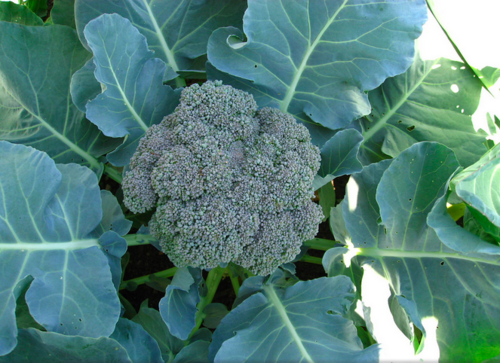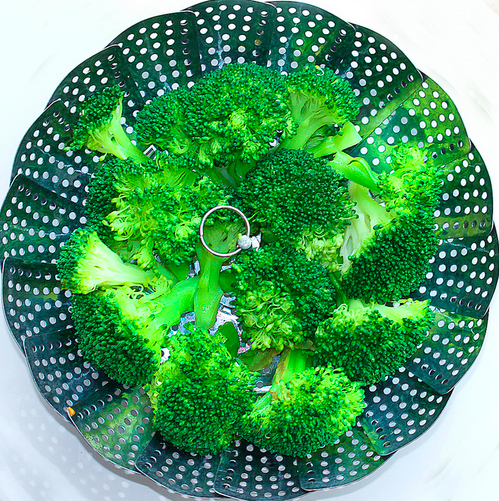(Adding a pic) |
(Some updates) |
||
| Line 4: | Line 4: | ||
Broccoli can be grown in garden beds (raised beds are best) or in containers. | Broccoli can be grown in garden beds (raised beds are best) or in containers. | ||
While broccoli is known as a winter vegetable, it can be grown all year round in cooler climates. | |||
== Description == | == Description == | ||
| Line 11: | Line 13: | ||
== Growing broccoli == | == Growing broccoli == | ||
Choose an area with soil that is rich in lime, well-draining and moist. The preferred soil pH is 6.5 to 7.5. If possible, used raised garden beds for optimal growth. The best position is a sunny one. | Choose an area with soil that is rich in lime, well-draining and moist. The preferred soil pH is 6.5 to 7.5. If possible, used raised garden beds for optimal growth. The best position is a sunny one. However, broccoli is fairly tolerant of areas with light shade and can handle exposed sites. | ||
Add plenty of well rotted manure or compost to the soil before planting. | Add plenty of well rotted manure or compost to the soil before planting. Broccoli thrives on soil rich in humus. It can be helpful to add a top dressing of manure too. | ||
Note that broccoli requires plenty of growing space. | |||
Plant seedlings in late summer. Place seedlings about 50cm or 20 inches apart in 60cm or 24-inch rows. | If using seeds, sow in late spring to early summer in cold climate zones; sow late summer to autumn in warmer zones and in autumn to winter in tropical zones. Sow seeds about 8cm apart, 1.5cm deep. Be aware that it is harder to grow from seeds direct in the garden and that it is recommended to grow in containers first, then transplant the seedlings to the garden. Broccoli seeds germinate quickly, so you should find that the seedlings will be ready within a few weeks after planting. | ||
Plant seedlings in late summer; they should measure about 5 to 8cm before planting. Place seedlings about 50cm or 20 inches apart in 60cm or 24-inch rows. This space between broccoli plants is needed to allow for strong growth and to prevent overcrowding. | |||
Add plenty of water and mulch well. The mulch will keep the soil moist and helps to prevent weed growth. | Add plenty of water and mulch well. The mulch will keep the soil moist and helps to prevent weed growth. | ||
| Line 24: | Line 28: | ||
Keep well watered but not water logged. Broccoli grows quickly and needs to stay moist; insufficient water tends to encourage going to seed without produce heads. When the heads mature, reduce the amount of watering. | Keep well watered but not water logged. Broccoli grows quickly and needs to stay moist; insufficient water tends to encourage going to seed without produce heads. When the heads mature, reduce the amount of watering. | ||
Keep broccoli weed-free. | Keep broccoli weed-free with a good mulch and regularly weed removal. | ||
Fertilise regularly with poultry or sheep pellet manure. Dig in well. Give additional fertiliser during growth. It will appreciate the weekly application of [[seaweed tea]] or compost tea or fertiliser (preferably a liquid fertiliser), as it is a heavy feeder. | |||
== Harvesting broccoli == | |||
Remove flower buds or the plant will focus on producing flowers and will stop growing. | |||
Harvest broccoli about 12 to 16 weeks (3 to 4 months) after growing from seedling stage. This is before the plant starts to flower. Cut the large central head and include a decent length of the stalk. Secondary buds appear once the principal stalk has been removed; leave the outer leaves and plant base intact to encourage additional edible head growth after removing the main stalk. | Harvest broccoli about 12 to 16 weeks (3 to 4 months) after growing from seedling stage. This is before the plant starts to flower. The head should be a tight formation of buds (the pre-flowering stage). | ||
Cut the large central head and include a decent length of the stalk. Secondary buds appear once the principal stalk has been removed; leave the outer leaves and plant base intact to encourage additional edible head growth after removing the main stalk. This means also leaving the plant's roots in the ground if you want a second harvest from the side shoots. | |||
== Problems == | == Problems == | ||
Watch for grubs. Broccoli attracts the cabbage moth and white butterfly. | Watch for grubs. Broccoli attracts the cabbage moth and white butterfly. It is also attractive to aphids. Aphids can be sprayed with soapy water and the caterpillars of the moth and butterfly can be handpicked off and disposed of. | ||
Broccoli can be affected by curling of the leaf, also known as whip tail. This shows that the plant has been deficient in molybdenum, a trace element. | Broccoli can be affected by curling of the leaf, also known as whip tail. This shows that the plant has been deficient in molybdenum, a trace element. | ||
| Line 42: | Line 52: | ||
[[File:Steamedbroccoli.png|center|500px]] | [[File:Steamedbroccoli.png|center|500px]] | ||
Broccoli can be eaten raw or cooked. For use in a salad, cut into small florets or finely and add to the salad. For cooking, the most popular methods are steaming and boiling. | Broccoli can be eaten raw or cooked. For use in a salad, cut into small florets or finely and add to the salad. For cooking, the most popular methods are steaming and boiling. | ||
It can be added to stir-fries, vegetable bakes, soups and curries. Small pieces are great as part of a pasta sauce. Broccoli matches well with eggs; steam first, then add to omelette, scrambled eggs or frittata. Broccoli hummus is an emerging snack treat. | |||
Old, less-than-pretty broccoli makes great soup. | |||
[[Category:Vegetables]] | [[Category:Vegetables]] | ||
Revision as of 20:05, 24 February 2017

Broccoli (Brassica oleracea) is a vegetable from the cabbage family. It is able to be grown in many climates, except for the hottest and coldest extremes. However, it needs a cool winter to mature, so this should be taken into consideration when determining whether or not it can be planted in a zone, with temperate and cold climate zones being the best choices.
Broccoli can be grown in garden beds (raised beds are best) or in containers.
While broccoli is known as a winter vegetable, it can be grown all year round in cooler climates.
Description
Broccoli forms into large flower heads. It is similar in appearance to cauliflower but more delicate and looser in arrangement. Each individual branch coming from the thick stalk look like little trees.
Broccoli has tiny yellow flowers when it blooms.
Growing broccoli
Choose an area with soil that is rich in lime, well-draining and moist. The preferred soil pH is 6.5 to 7.5. If possible, used raised garden beds for optimal growth. The best position is a sunny one. However, broccoli is fairly tolerant of areas with light shade and can handle exposed sites.
Add plenty of well rotted manure or compost to the soil before planting. Broccoli thrives on soil rich in humus. It can be helpful to add a top dressing of manure too.
Note that broccoli requires plenty of growing space.
If using seeds, sow in late spring to early summer in cold climate zones; sow late summer to autumn in warmer zones and in autumn to winter in tropical zones. Sow seeds about 8cm apart, 1.5cm deep. Be aware that it is harder to grow from seeds direct in the garden and that it is recommended to grow in containers first, then transplant the seedlings to the garden. Broccoli seeds germinate quickly, so you should find that the seedlings will be ready within a few weeks after planting.
Plant seedlings in late summer; they should measure about 5 to 8cm before planting. Place seedlings about 50cm or 20 inches apart in 60cm or 24-inch rows. This space between broccoli plants is needed to allow for strong growth and to prevent overcrowding.
Add plenty of water and mulch well. The mulch will keep the soil moist and helps to prevent weed growth.
Caring for broccoli
Keep well watered but not water logged. Broccoli grows quickly and needs to stay moist; insufficient water tends to encourage going to seed without produce heads. When the heads mature, reduce the amount of watering.
Keep broccoli weed-free with a good mulch and regularly weed removal.
Fertilise regularly with poultry or sheep pellet manure. Dig in well. Give additional fertiliser during growth. It will appreciate the weekly application of seaweed tea or compost tea or fertiliser (preferably a liquid fertiliser), as it is a heavy feeder.
Harvesting broccoli
Remove flower buds or the plant will focus on producing flowers and will stop growing.
Harvest broccoli about 12 to 16 weeks (3 to 4 months) after growing from seedling stage. This is before the plant starts to flower. The head should be a tight formation of buds (the pre-flowering stage).
Cut the large central head and include a decent length of the stalk. Secondary buds appear once the principal stalk has been removed; leave the outer leaves and plant base intact to encourage additional edible head growth after removing the main stalk. This means also leaving the plant's roots in the ground if you want a second harvest from the side shoots.
Problems
Watch for grubs. Broccoli attracts the cabbage moth and white butterfly. It is also attractive to aphids. Aphids can be sprayed with soapy water and the caterpillars of the moth and butterfly can be handpicked off and disposed of.
Broccoli can be affected by curling of the leaf, also known as whip tail. This shows that the plant has been deficient in molybdenum, a trace element.
Downy mildew affects broccoli in moist, cool environments. You can reduce the possibility of this occurring through ensuring it has a sunny and well-ventilated position to grow in.
Do not over water broccoli; it will not thrive if water logged.
Uses for broccoli

Broccoli can be eaten raw or cooked. For use in a salad, cut into small florets or finely and add to the salad. For cooking, the most popular methods are steaming and boiling.
It can be added to stir-fries, vegetable bakes, soups and curries. Small pieces are great as part of a pasta sauce. Broccoli matches well with eggs; steam first, then add to omelette, scrambled eggs or frittata. Broccoli hummus is an emerging snack treat.
Old, less-than-pretty broccoli makes great soup.